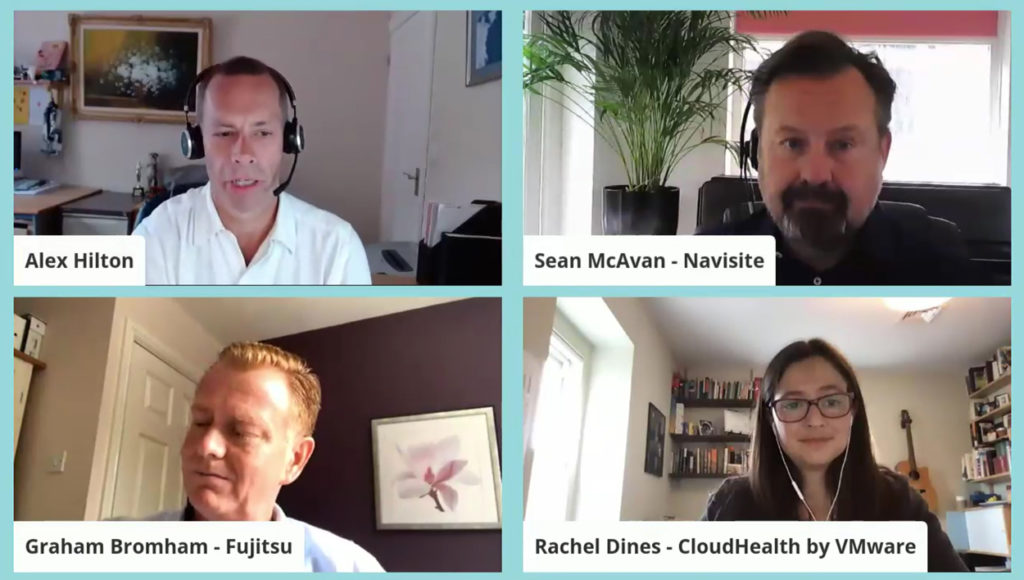Driven by the COVID-19 pandemic, enterprises around the world are deploying multi-cloud solutions to support remote workers. When done carefully, that strategy offers potential benefits like increased reliability, flexibility, capacity, and redundancy.
But there are also serious challenges in designing a multi-cloud approach, such as integrating public, private, or hybrid cloud platforms. Other issues include increased operational complexity, understanding varied cost models and billing, and implementing additional security and governance measures.
“One approach to navigating the multi-cloud maze is to establish a centralized cloud center of excellence,” said Rachel Dines, senior director for product marketing, CloudHealth by VMware. “This group would look across finance, infrastructure, security, architecture, and applications to make sure the organization achieves the desired business outcomes from the cloud.”
Dines was a panelist at a recent BrightTalk webinar, “The Multi-Cloud Maze: Making the Right Cloud Choice,” hosted by Alex Hilton, CEO, Cloud Industry Forum. Other panelists were Sean McAvan, managing director, EMEA, Navisite; and Graham Bromham, head of cloud and managed service provider sales, Fujitsu UK.

Picking a vendor
Kicking off the discussion, Hilton asked the panelists about the leading cloud vendors: Microsoft, Amazon Web Services (AWS) and Google. “Does it matter which vendor an organization chooses?” he said. “How do you make those decisions?”
McAvan said all three providers held up well during the COVID-19 crisis. “What you want to do is step back, think about your business goals and outcomes, and then pick a target cloud,” he said. “Look at your current on-premise and cloud platforms, and design the best approach going forward.”
Dines said there is little differentiation from a price, performance and availability standpoint. But there is more differentiation on top, such as artificial intelligence (AI) offerings or platform as a service (PaaS). “Talk with your developers to see if they have a preference, and look at the governance issue,” she added.
Organizations should also look at geographic locations, said several panelists. If workloads to be close to a physical facility for compliance reasons or to reduce latency, one cloud provider might have an edge over another.
“Geography is important,” said McAvan. “If you have data that can’t move from one nation to another, then the hybrid solution might be best, as you could maintain a data center in your country.”
Bromham agreed, noting that a hybrid approach can reduce the stresses of digital transformation for a business. “You can use the cloud where appropriate and emulate your current practices,” he said.
Security and support
Next, Hilton asked the panelists about security and support. “Multi-public clouds can work well when thinking about disaster recovery or capacity issues,” said McAvan. “Some platforms may be better than others for certain workloads, especially if you are building apps in the cloud.”
He added that it can be difficult to have in-house professionals support different cloud platforms. “It’s easier to secure a multi-cloud experience if you work with partners who can provide those tools.”
Dines said that the cloud is not inherently less secure than a data center. “Things change so fast in the cloud, that security issues can get out of control,” she added. “You may want to engage a third-party solution to do the monitoring and alerting if something goes wrong, such as a loss of credentials or a misprovisioning situation.”
Growing demand for cloud
One of the impacts of COVID-19 has been growing demand for desktop as a service, and increased capacity on VPNs, said McAvan. Organizations are seeing that applications have to be made available permanently through the cloud.
Dine says many enterprises are “big adapters” of the public cloud. “This can be a good time to reinvent your IT infrastructure,” she said. “Or you can cut costs by delivering services online. It’s been a forced acceleration, with so much changing all at once.”
Looking ahead, Dines said the average worker will need more IT support than in the pre-COVID era. “Migrating to the cloud involves a cost, so you might need to adjust budgets, perhaps taking from facilities and moving to IT.”
Wrapping up the session, McAvan said moving to the cloud is not the end of the journey. “You usually have to adopt additional technology and keep looking for ways to drive value from the data,” he said. “Digital transformation is an ongoing process.”
